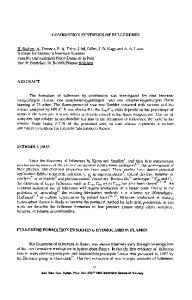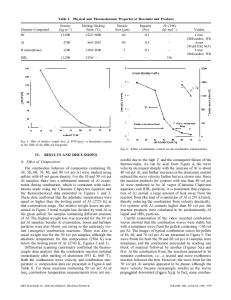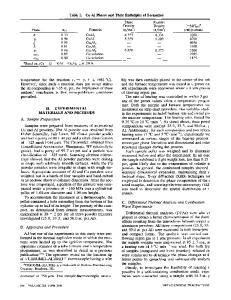Combustion synthesis of ceramic-metal
- PDF / 1,649,234 Bytes
- 7 Pages / 597 x 774 pts Page_size
- 63 Downloads / 391 Views
I.
INTRODUCTION
C O M B U S T I O N synthesis is being used to produce ceramics, intermetallics, and composite materials. I11 However, the relatively high levels of porosity, e.g., 50 pct, in the products has led to some limitations in the application of this technique for producing advanced materials. Various densifying techniques have been explored, including hot compaction and hipping, explosive forming, and shock compaction. 121 Most of these techniques can provide high densities, e.g., 99 pct+ of theoretical density, but also incur an economic penalty. This research program is currently investigating the use of an excess amount of liquid metal generated within the exothermic reaction system for facilitating high-density ceramic-metal composite materials. At the same time, incorporating a ductile metal into a brittle ceramic composite matrix has considerable potential for substantial improvements in fracture toughness for both low- and high-temperature applications. A novel application of combustion synthesis is currently being investigated which involves the use of an excess metal reactant, e.g., A1. The aluminum is liquid well before the maximum or combustion temperature, T~, is reached and is allowed to simultaneously infiltrate the porous ceramic matrix created from the exothermic, combustion synthesis reaction. This article will discuss H.J. FENG, Doctoral Candidate, and JOHN J. MOORE, Professor and Department Head, are with the Department of Metallurgical and Materials Engineering, Colorado School of Mines, Golden, CO 80401. D.G. WIRTH, Vice President Research, is with Coors Ceramics Company, Golden, CO 80401. This paper is based on a presentation made in the symposium "Reaction Synthesis of Materials" presented during the TMS Annual Meeting, New Orleans, LA, February 17-21, 1991, under the auspices of the TMS Powder Metallurgy Committee. METALLURGICAL TRANSACTIONS A
the initial observations of the TiC-AI203-AI system, using the reaction 3TIO2 + 3C + (4 + x) Al = 3TiC + 2A1203 + xA1
[1] When x = 0, the combustion synthesis reaction products, i.e., TiC-A1203, do not contain any excess liquid aluminum in the product. When x is greater than zero, an excess liquid aluminum is produced during the combustion synthesis reaction and is allowed to infiltrate the ceramic composite matrix, i.e., TiC + A1203, which is known to be porous, as shown in Figure 1.ta] The morphology of the porosity has been shown to exist in two major forms: (1) long radial pores, thought to be due mainly to outgassing, and (2) small micropores, thought to be due mainly to volume changes between reactants and products in the combustion synthesis reaction. The particle size of the reactants and the green density to which the powdered reactants are compressed prior to initiating the reaction have been found to be important process control parameters for controlling product porosity (Figure 1). The enthalpy-temperature plots for the TiC-AIEOa-A1 reaction system are given in Figure 2 for x = 0, 2, 4, and 9. Examination of these plots indic
Data Loading...











